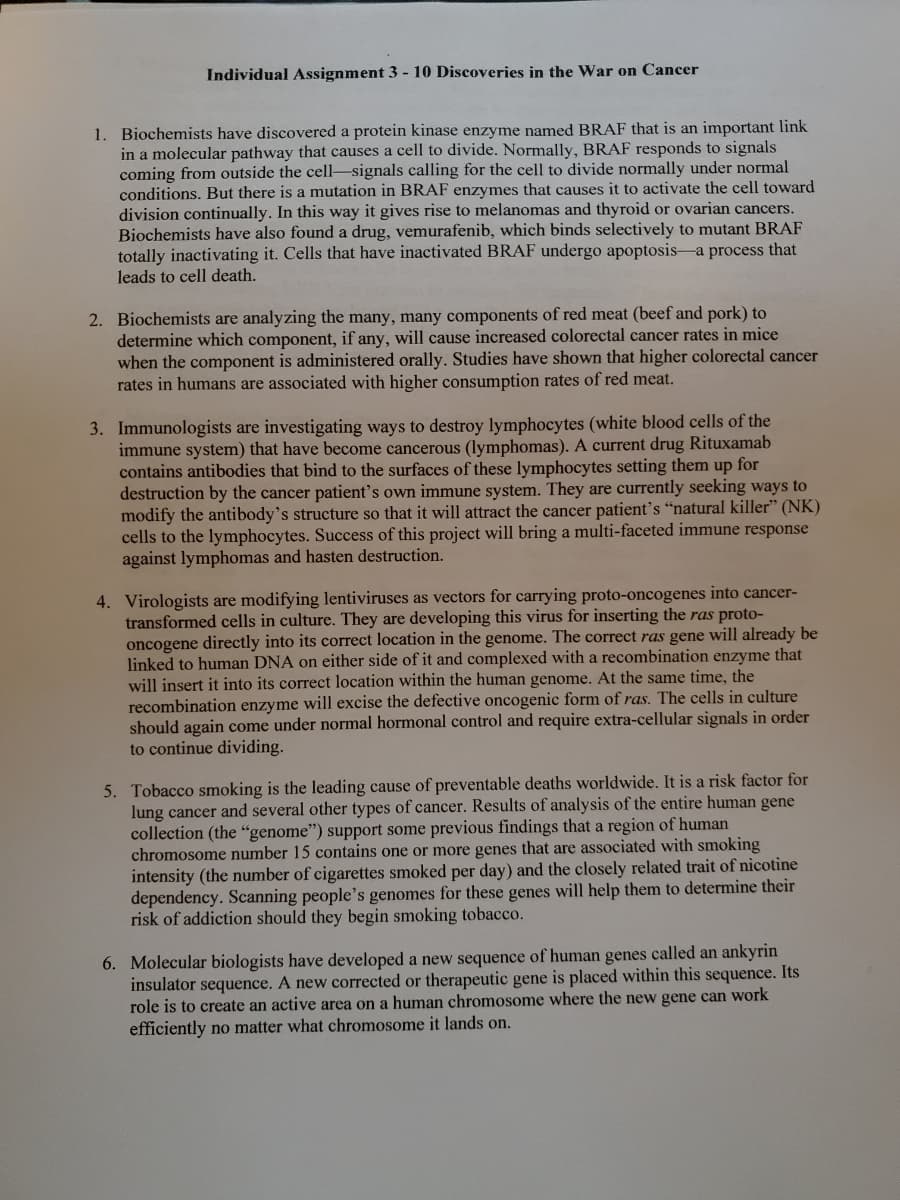Which is a.) Reduction of cancer risks b.) Correction of cancer genes or c.) Destruction of cancer tissues Only most likely choice for the following
Which is a.) Reduction of cancer risks b.) Correction of cancer genes or c.) Destruction of cancer tissues Only most likely choice for the following
Biology: The Unity and Diversity of Life (MindTap Course List)
14th Edition
ISBN:9781305073951
Author:Cecie Starr, Ralph Taggart, Christine Evers, Lisa Starr
Publisher:Cecie Starr, Ralph Taggart, Christine Evers, Lisa Starr
Chapter31: Animal Tissues And Organ Systems
Section: Chapter Questions
Problem 14SQ: Match each term with the most suitable description. ______ exocrine gland a. signaling cell in...
Related questions
Question
Which is a.) Reduction of cancer risks b.) Correction of cancer genes or c.) Destruction of cancer tissues
Only most likely choice for the following

Transcribed Image Text:Individual Assignment 3 - 10 Discoveries in the War on Cancer
1. Biochemists have discovered a protein kinase enzyme named BRAF that is an important link
in a molecular pathway that causes a cell to divide. Normally, BRAF responds to signals
coming from outside the cell-signals calling for the cell to divide normally under normal
conditions. But there is a mutation in BRAF enzymes that causes it to activate the cell toward
division continually. In this way it gives rise to melanomas and thyroid or ovarian cancers.
Biochemists have also found a drug, vemurafenib, which binds selectively to mutant BRAF
totally inactivating it. Cells that have inactivated BRAF undergo apoptosis-a process that
leads to cell death.
2. Biochemists are analyzing the many, many components of red meat (beef and pork) to
determine which component, if any, will cause increased colorectal cancer rates in mice
when the component is administered orally. Studies have shown that higher colorectal cancer
rates in humans are associated with higher consumption rates of red meat.
3. Immunologists are investigating ways to destroy lymphocytes (white blood cells of the
immune system) that have become cancerous (lymphomas). A current drug Rituxamab
contains antibodies that bind to the surfaces
destruction by the cancer patient's own immune system. They are currently seeking ways to
modify the antibody's structure so that it will attract the cancer patient's "natural killer" (NK)
cells to the lymphocytes. Success of this project will bring a multi-faceted immune response
against lymphomas and hasten destruction.
these lymphocytes setting them up for
4. Virologists are modifying lentiviruses as vectors for carrying proto-oncogenes into cancer-
transformed cells in culture. They are developing this virus for inserting the ras proto-
oncogene directly into its correct location in the genome. The correct ras gene will already be
linked to human DNA on either side of it and complexed with a recombination enzyme that
will insert it into its correct location within the human genome. At the same time, the
recombination enzyme will excise the defective oncogenic form of ras. The cells in culture
should again come under normal hormonal control and require extra-cellular signals in order
to continue dividing.
5. Tobacco smoking is the leading cause of preventable deaths worldwide. It is a risk factor for
lung cancer and several other types of cancer. Results of analysis of the entire human gene
collection (the "genome") support some previous findings that a region of human
chromosome number 15 contains one or more genes that are associated with smoking
intensity (the number of cigar
dependency. Scanning people's genomes for these genes will help them to determine their
risk of addiction should they begin smoking tobacco.
smoked per day) and the closely related trait of nicotine
6. Molecular biologists have developed a new sequence of human genes called an ankyrin
insulator sequence. A new corrected or therapeutic gene is placed within this sequence. Its
role is to create an active area on a human chromosome where the new gene can work
efficiently no matter what chromosome it lands on.
Expert Solution
This question has been solved!
Explore an expertly crafted, step-by-step solution for a thorough understanding of key concepts.
This is a popular solution!
Trending now
This is a popular solution!
Step by step
Solved in 4 steps

Knowledge Booster
Learn more about
Need a deep-dive on the concept behind this application? Look no further. Learn more about this topic, biology and related others by exploring similar questions and additional content below.Recommended textbooks for you

Biology: The Unity and Diversity of Life (MindTap…
Biology
ISBN:
9781305073951
Author:
Cecie Starr, Ralph Taggart, Christine Evers, Lisa Starr
Publisher:
Cengage Learning

Biology 2e
Biology
ISBN:
9781947172517
Author:
Matthew Douglas, Jung Choi, Mary Ann Clark
Publisher:
OpenStax

Anatomy & Physiology
Biology
ISBN:
9781938168130
Author:
Kelly A. Young, James A. Wise, Peter DeSaix, Dean H. Kruse, Brandon Poe, Eddie Johnson, Jody E. Johnson, Oksana Korol, J. Gordon Betts, Mark Womble
Publisher:
OpenStax College

Biology: The Unity and Diversity of Life (MindTap…
Biology
ISBN:
9781305073951
Author:
Cecie Starr, Ralph Taggart, Christine Evers, Lisa Starr
Publisher:
Cengage Learning

Biology 2e
Biology
ISBN:
9781947172517
Author:
Matthew Douglas, Jung Choi, Mary Ann Clark
Publisher:
OpenStax

Anatomy & Physiology
Biology
ISBN:
9781938168130
Author:
Kelly A. Young, James A. Wise, Peter DeSaix, Dean H. Kruse, Brandon Poe, Eddie Johnson, Jody E. Johnson, Oksana Korol, J. Gordon Betts, Mark Womble
Publisher:
OpenStax College

Biology: The Unity and Diversity of Life (MindTap…
Biology
ISBN:
9781337408332
Author:
Cecie Starr, Ralph Taggart, Christine Evers, Lisa Starr
Publisher:
Cengage Learning